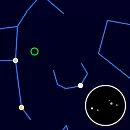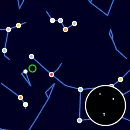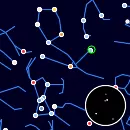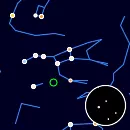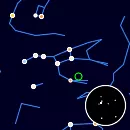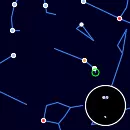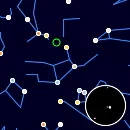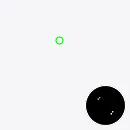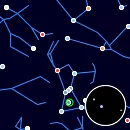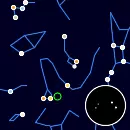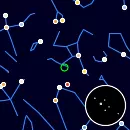Multiple Star Systems Visible Tonight: Beyond Binary Stars
Sky Map
Celectial bearing and elevation at 21:22
Multiple star systems are fascinating celestial arrangements featuring three or more stars grouped together, which may or may not be gravitationally bound. These systems can range from tightly orbiting pairs within a larger stellar structure to loosely associated stars that share a common region of the sky. They offer a unique glimpse into the diversity of stellar interactions and the complex dynamics that shape the universe. Whether gravitationally linked or optical groupings, multiple star systems captivate observers with their varied configurations and stories.
16224+3348
Multiple Star System
6-star star system in the constellation Corona Borealis with primary and secondary components of magnitudes 5.39 and 5.58, separated by 6.2 arcminutes.
01562+3715
Multiple Star System
Quadruple star system in the constellation Andromeda with primary and secondary components of magnitudes 5.79 and 6.07, separated by 2.9 arcminutes.
03459+2433
Multiple Star System
6-star star system in the constellation Taurus with primary and secondary components of magnitudes 5.75 and 6.42, separated by 2.5 arcminutes.
12021+4303
Multiple Star System
7-star star system in the constellation Ursa Major with primary and secondary components of magnitudes 5.24 and 6.72, separated by 5.3 arcminutes.
10435+4612
Multiple Star System
8-star star system in the constellation Ursa Major with primary and secondary components of magnitudes 5.21 and 7.35, separated by 4.8 arcminutes.
01535+1918
Multiple Star System
5-star star system in the constellation Aries with primary and secondary components of magnitudes 4.52 and 4.58, separated by 8.9 arcseconds.
12417-0127
Multiple Star System
9-star star system in the constellation Virgo with primary and secondary components of magnitudes 3.48 and 3.53, separated by 6.5 arcseconds.
09205-0933
Multiple Star System
Quadruple star system in the constellation Hydra with primary and secondary components of magnitudes 4.91 and 7.03, separated by 3.8 arcminutes.
12289+2555
Multiple Star System
7-star star system in the constellation Coma Berenices with primary and secondary components of magnitudes 5.23 and 6.64, separated by 2.4 arcminutes.
13284+1347
Multiple Star System
5-star star system in the constellation Virgo with primary and secondary components of magnitudes 5.04 and 8.69, separated by 5.1 arcminutes.
12413-1301
Multiple Star System
Quadruple star system in the constellation Corvus with primary and secondary components of magnitudes 5.88 and 5.89, separated by 6.9 arcseconds.
05350-0600
Multiple Star System
Quadruple star system in the constellation Orion with primary and secondary components of magnitudes 4.70 and 5.51, separated by 35.8 arcseconds.
17053+5428
Multiple Star System
Quadruple star system in the constellation Draco with primary and secondary components of magnitudes 5.66 and 5.69, separated by 4.4 arcseconds.
17209+2430
Multiple Star System
6-star star system in the constellation Hercules with primary and secondary components of magnitudes 5.12 and 9.33, separated by 3.7 arcminutes.
17419+7209
Multiple Star System
6-star star system in the constellation Draco with primary and secondary components of magnitudes 4.60 and 5.59, separated by 32 arcseconds.
09287+4536
Multiple Star System
Quadruple star system in the constellation Ursa Major with primary and secondary components of magnitudes 5.50 and 7.80, separated by 1.5 arcminute.
11279+0251
Multiple Star System
6-star star system in the constellation Leo with primary and secondary components of magnitudes 5.05 and 7.47, separated by 1.4 arcminute.
10084+1158
Multiple Star System
5-star star system in the constellation Leo with primary and secondary components of magnitudes 1.40 and 8.24, separated by 2.8 arcminutes.
06090+0230
Multiple Star System
Quadruple star system in the constellation Orion with primary and secondary components of magnitudes 5.68 and 6.68, separated by 29.2 arcseconds.
10535-2008
Multiple Star System
Quadruple star system in the constellation Hydra with primary and secondary components of magnitudes 5.29 and 9.60, separated by 2.3 arcminutes.

